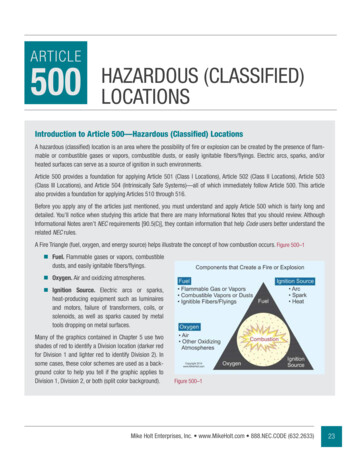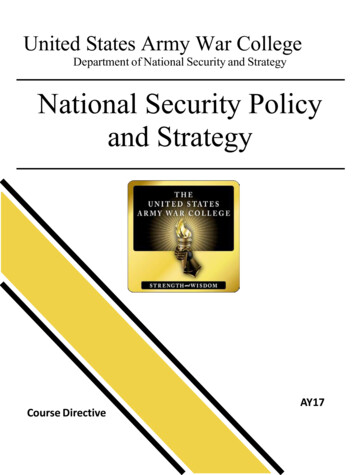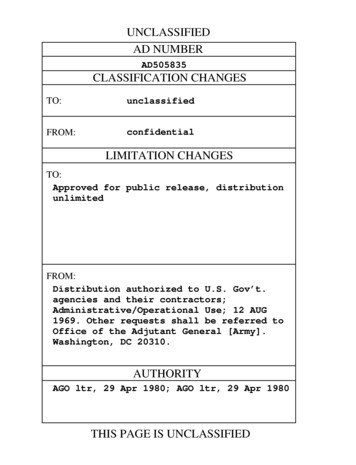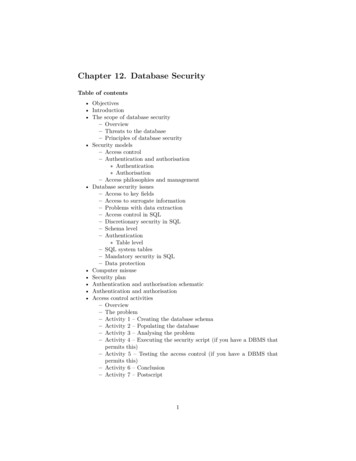
Transcription
MarkingClassifiedNational SecurityInformationAS REQUIRED BYEXECUTIVE ORDER 13526, CLASSIFIED NATIONAL SECURITY INFORMATIONDECEMBER 29, 2009, AND32 CFR PART 2001, ISOO IMPLEMENTING DIRECTIVEJUNE 25, 2010DECEMBER 2010Revision 4, January 2018This document is UNCLASSIFIED. Any classificationmarkings are for training use only.II
-- This page left blank --
TABLE OF CONTENTSIntroductioniiSECTION 1: Required Elements of MarkingPortion MarkingOverall Classification MarkingClassification Authority Block1379SECTION 2: Derivative Classification MarkingsExamplesDeclassification Instruction Missing from Source DocumentUse of 25X1 through 25X9 ExemptionsSecurity Classification GuidesClassification by Compilation131416171820SECTION 3: Marking ExamplesE-MailExcel SpreadsheetsWorking PapersDatabasesClassification Markings in the Electronic Environment232428293030SECTION 4: Legacy Markings31SECTION 5: Additional or Special MarkingsClassification ExtensionsForeign Government InformationCommingling RD/FRD with NSITransmittal DocumentsOptions for Marking Complex SlidesDeclassified DocumentsMarking of Electronic Storage Equipment3536373839414344SECTION 6: Quick Reference45-i-
INTRODUCTIONExecutive Order (E.O.) 13526 and its implementing directive, 32 CFR Part 2001, prescribe a uniform securityclassification system. This system requires that standard markings be applied to classified information.Except in extraordinary circumstances, or as approved by the Director of the Information Security OversightOffice (ISOO), the marking of classified information shall not deviate from the prescribed formats. Markingsshall be uniformly and conspicuously applied to leave no doubt about the classified status of theinformation, the level of protection required, and the duration of classification. Since a booklet of this sizecannot illustrate every conceivable situation, please refer to the implementing directive, other ISOOissuances, and any instructions issued by your organization for further clarification. Consult your securitymanager if you have any questions.This booklet is unclassified, and as it is in the public domain, it may be reproduced without permission. Allclassification markings used are for illustration purposes only. All previous booklets and the guidancecontained in them are rescinded.Reminders Original classification is the initial determination that information required, in the interest of the nationalsecurity, protection against unauthorized disclosure. Only individuals specifically authorized in writing by the President, the Agency Head, or theSenior Agency Official may classify documents originally. OCAs must receive training on theirresponsibilities annually. Derivative classification is the incorporating, paraphrasing, restating, or generating in new forminformation that is already classified, and marking the newly developed material consistent with theclassification markings that apply to the source document. Only individuals with the appropriate security clearance, who are required by their work torestate classified source information, may derivatively classify information. Derivative classifiersare required to receive training at least once every two years. Markings other than “Top Secret,” “Secret,” and “Confidential” shall not be used to identify classifiednational security information. Information shall not be classified for any reason unrelated to the protection of the national security. Classifiers and authorized holders are responsible for ensuring that information is appropriately classifiedand properly marked. Individuals who believe that information in their possession is inappropriately classified, orinappropriately unclassified, are expected to bring their concerns to the attention of responsible officials.- ii -
Section 1:Required Elements of Marking-1-
Section 1: Required Elements of MarkingRequired markings under E.O. 13526 include: Portion markings; Overall classification markings; and Classification authority block consisting of: A “Classified By” line to include the identity, by name and position, or by personalidentifier of the classifier, and if not otherwise evident, the agency and office oforigin. The “Reason” for classification as provided in section 1.4 of the Order for originally classifieddocuments, or “Derived From” for derivatively classified documents. A “Declassify On” line which shall indicate one of the following durations of classification: A date or event for declassification that corresponds to the lapse of theinformation’s national security sensitivity, which is equal to or less than 10 yearsfrom the date of the original decision. A date not to exceed 25 years from the date of the document creation. If the classified information should clearly and demonstrably be expected to revealthe identity of a confidential human source or a human intelligence source, no dateor event shall be annotated and the marking “50X1-HUM” shall be used. If the classified information should clearly and demonstrably be expected to revealkey design concepts of weapons of mass destruction, no date or event shall beannotated and the marking “50X2-WMD” shall be used. 25X1 through 25X9, with a date or event (as approved by ISCAP)Note: Refer to ISOO Notice 2018-01 if using an event for a declassification instruction.-2-
Section 1: Required Elements of MarkingPortion MarkingIWhy do we portion mark?What constitutes a portion?(This list is not all let points/sub-bullet pointsGraphics (maps, photos, pictures, etc.)TablesChartsPortion markings identify the informationthat must be protected and the level ofprotection that is required.*Documents that are not portion markedshall not be used as source documentsfor derivatively classified documents.Portion marking is a requirement on all classified documents; originally classifiedand derivatively classified to include e-mails. This also applies to all unclassifieddocuments (including e-mails) that reside on a classified system.NOTE: Portion marking waivers may be requested by an agency head or senioragency official. Such requests shall be submitted to the Director of ISOO.See 32 CFR Part 2001.24(k) for more information.-3-
Section 1: Required Elements of MarkingPortion MarkingIExamplesTITLE:(U) Required Elements of MarkingSubject: (U) Required Elements of Marking1. (S) The implementing directive, 32 CFR 2001.21, defines a portion as “ordinarily aparagraph, but including subjects, titles, graphics, tables, charts, bullet statements, subparagraphs, classified signature blocks, bullets, and other portions within slidepresentations.a. (U) All portions must be appropriately marked to indicate which portions are classifiedand which portions are not classified. (U) Main bullet point 1 (S) Sub-bullet 1 (U) Sub-bullet 2 (TS) Sub-bullet 3 (C) Sub-bullet 4 (S) Sub-bullet 5SECRETEuropeAsiaCaribbeanMexico &Central AmericaAfricaSouthAmericaAustraliaSECRETNew ZealandThe map itself is considered a portion and is marked top and bottomwith the classification of the map as a whole. For graphics, it isrecommended you spell out the classification so that it is clearly visible.-4-
Section 1: Required Elements of MarkingPortion MarkingIExamples(U) Examples ofPowerPoint SlideMarkingsMay 27, 2010(U) Example of Slide Markings (S) This bullet contains “Secret” information.Therefore, this portion will be marked with thedesignation “S” in parentheses preceding the portion. (U) This bullet contains “Unclassified” information.Therefore this portion will be marked with thedesignation “U” in parentheses preceding the portion.In this example, the portion markingapplied to the graphic is spelled out(SECRET) instead of being abbreviated.This is a recommended way to applymarkings that provide distinctionbetween the classified status of agraphic, the title of a graphic, and theoverall classification of a slide.(U) This slidedemonstrates how toproperly portion marka slide that contains achart, graph, picture,etc. The title of thegraph is portionmarked and the graphas a separate object isportion marked.(U) The text is alsoportion marked.-5-(U) DeclassificationSECRET 1st Qtr 2nd Qtr 3rd Qtr 4th Qtr
Section 1: Required Elements of MarkingIPortion MarkingU) ISOO'S MISSIONS) We support the President by ensuring that the Government protects and providesproper access to information to advance the national and public interest. We lead effortsto standardize and assess the management of classified and controlled unclassifiedinformation through oversight, policy development, guidance, education, and reporting.(U) FUNCTIONS (S) Develop implementing directives and instructions. (S) Review and approve agency implementing regulations. (S) Review requests for original classification authority from agencies. (U) Maintain liaison relationships with agency counterparts and conduct on-site anddocument reviews to monitor agency compliance. (S) Develop and disseminate security education materials for Government andindustry; monitor security education and training programs. (S) Receive and take action on complaints and suggestions with respect to theadministration of the program established under the Order. (U) Collect and analyze relevant statistical data and, along with other information,report them annually to the President.(U)(U)GOALS (U) Promote programs for protection of classified and controlled unclassifiedinformation. (U) Reduce classification and control activity to the minimum necessary. (S) Ensure that the systems for declassification and decontrol operate as required. (S) Provide expert advice and guidance to constituents. (U) Collect, analyze, and report valid information about the status of agency programs.Portion marking of the titlePortion marking of theheadings, paragraphs,and bullet points(U) Plasmodiu(U) Number of OCAs(U) Original ClassificationAuthoritiesFY 2015 {U) Travel to liver-1,3361,5001,000{SJ Mosquito bite(5) Sporozoit cs enter blood-(IJ)I IPpa tocytes(S) Asexua l g rowth (I J) .hirnn-:r. m P.mrdt :'\-( ) M PrmnitP.s to hlonrl{U) M850-0lu uluud (U) l'l.elease trophc-zoi-Ce!i,merozoites, schizoms-500e l UlUJ(IJ) nfffl't n,::{(.) MP.rnrn itP. t ranstnrl'Tl-'tion (L) t:iamcto 1cs{SJ Passed to new mosq uito13Portion marking ofthe title of thepictureTop SecretSecretConfidential(U) Classification Level(S) Total Number of OCAs: 2,199-6-Portion marking ofthe picture
Section 1: Required Elements of MarkingOverall Classification MarkingI The overall classification of a document is determined by the highest level of classification of any one portionwithin the document. Conspicuously place the overall classification at the top and bottom of the page. If the document contains more than one page, place the overall marking at the top and bottom of theoutside of the front cover, on the title page, on the first page, and on the outside of the back cover (if any). Mark other internal pages either with the overall classification or with a marking indicating the highestclassification level of information contained on that page.Examples of overall classification markingsSECRETSubject: (U) Required Elements of Marking1. (S) The implementing directive, 32 CFR 2001.21, defines a portion as “ordinarily aparagraph, but including subjects, titles, graphics, tables, charts, bullet statements, subparagraphs, classified signature blocks, bullets, and other portions within slidepresentations.a. (U) All portions must be appropriately marked to indicate which portions are classifiedand which portions are not classified.SECRETTOP SECRET (U) Main bullet point 1 (S) Sub-bullet 1 (U) Sub-bullet 2 (TS) Sub-bullet 3 (C) Sub-bullet 4 (S) Sub-bullet 5TOP SECRET(U) This slidedemonstrates how toproperly portion marka slide that contains achart, graph, picture,etc. The title of thegraph is portionmarked and the graphas a separate object isportion marked.(U) The text is alsoportion marked.SECRET(U) Declassification 1st Qtr 2ndQtr 3rdQtr 4thQtrSECRETSECRETNOTE: Some agencies require additional dissemination and control markings that accompany theoverall classification markings.Contact your security manager for agency-specific guidelines.I-7-I
Section 1: Required Elements of MarkingOverall Classification MarkingIExamples of overall classification markings(U) ISOO'S MISSIONSECRET(S) We support the President by ensuring that the Government protects and providesproper access to information to advance the national and public interest. We lead effortsto standardize and assess the management of classified and controlled unclassifiedinformation through oversight, policy development, guidance, education, and reporting.SECRET(U) FUNCTIONS (S) Develop implementing directives and instructions. (S) Review and approve agency implementing regulations. (S) Review requests for original classification authority from agencies. (U) Maintain liaison relationships with agency counterparts and conduct on-site anddocument reviews to monitor agency compliance. (S) Develop and disseminate security education materials for Government andindustry; monitor security education and training programs. (S) Receive and talce action on complaints and suggestions with respect to theadministration of the program established under the Order. (U) Collect and analyze relevant statistical data and, along with other information,report them annually to the President(U)(U)GOALS (U) Promote programs for protection of classified and controlled unclassifiedinformation. (U) Reduce classification and control activity to the minimum necessary. (S) Ensure that the systems for declassification and decontrol operate as required. (S) Provide expert advice and guidance to constituents. (U) Collect, analyze, and report valid information about the status of agency programs.SECRETSECRETSECRETMay 27, 2010(U) Number of OCAs(U) Examples ofPowerPoint SlideMarkingsSECRET(U) Original Classification AuthoritiesFY 2015SECRET1,3361,5008501,000500013Top SecretSECRETSecretConfidential(U) Classification Level(S) Total Number of OCAs: 2,199NOTE: Some agencies require additional dissemination and control markings that accompany theoverall classification markings.Contact your security manager for agency-specific guidelines.I-8-I
Section 1: Required Elements of MarkingClassification Authority BlockIThis is the classification authority block for an originally classified document.OCA name and position,or personal identifier-The category of classified informationannotated in Section 1.4 of E.O. 13526Classified By: John E. Doe, Chief, Division 5Reason: 1.4(a)Declassify On: 20150627Declassification instruction,not to exceed 25 years fromthe date of the documentNOTE: If not otherwise evident, the agency and office of originshall be identified and placed immediately following the name andposition, or personal identifier provided in the “Classified By” line. A date or event that is less than 10 years from thedate of original classification (date of document isJuly 1, 2010)Classified By: John E. Doe, Chief Division 5Reason: 1.4(a)Declassify On: 20180701 A date that is 10 years from the date of theoriginal classification decision (date of documentis July 1, 2010)Classified By: John E. Doe, Chief Division 5Reason: 1.4(a)Declassify On: 20200701 A date not to exceed 25 years from the date of theoriginal classification decision (date of documentis July 1, 2010).Classified By: John E. Doe, Chief Division 5Reason: 1.4(a)Declassify On: 20350701 Exceptions to this sequence: If the information should clearly anddemonstrably be expected to reveal the identityof a confidential human source or a humanintelligence source, the duration ofclassification shall be up to 75 years and shallbe designated as 50X1-HUM. If the information should clearly anddemonstrably be expected to reveal key designconcepts of weapons of mass destruction, theduration shall be up to 75 years and shall bedesignated as 50X2-WMD.Classified By: John E. Doe, Chief Division 5Reason: 1.4(c)Declassify On: 50X1-HUMClassified By: John E. Doe, Chief Division 5Reason: 1.4(h)Declassify On: 50X2-WMDNOTE: When 50X1-HUM and 50X2-WMD are used, a specific date or event for declassification of the information will not beused. Approval by the ISCAP is not required prior to agency use of 50X1-HUM or 50X2-WMD; however, agencies shouldprovide details in their classification guides concerning the use of these markings to enable effective use.-9-
Section 1: Required Elements of MarkingClassification Authority BlockIThis is the classification authority block for a derivatively classified document.Name and position, or personal identifier ofthe individual who created the document.Do not use group name, office name, orteam name.The source of the informationDeclassification instruction-Classified By: Joe Carver, DirectorDerived From: Department of Good Works Memorandumdated June 27, 2010, Subj: (U) ExamplesDeclassify On: 20150627NOTE: If not otherwise evident, the agency and office of originshall be identified and placed immediately following the name andposition, or personal identifier provided in the “Classified By” line.Derivative classification is the act of incorporating, paraphrasing, restating, or generating in new forminformation that is already classified, and marking the newly developed material consistent with themarkings of the source information. The source information ordinarily consists of a classified document ordocuments, or a classification guide issued by an original classification authority.When using a classified source document as the basis for derivative classification, the markings on thesource document determine the markings to be applied to the derivative document. When using aclassification guide as the basis for derivative classification, the instructions provided by the guide are to beapplied to the derivative document.For documents derived from a single source:Classified By: Name and position, or personal identifier of the individual who created the document. Donot use group name, office name, or team name.Derived From: Precisely identify the source document or the classification guide on the ‘‘Derived From’’line.Declassify On: The derivative classifier shall carry forward the instructions on the ‘‘Declassify On’’ line fromthe source document to the derivative document, or the duration instruction from the classification ordeclassification guide.NOTE: The date for declassification may be displayed either by spelling outthe month (June 27, 2015), or numerically (20150627). When displayednumerically, the following format must be used: YYYYMMDD.-10-
Section 1: Required Elements of MarkingClassification Authority BlockIFor Documents Derived From Multiple SourcesClassified By: Name and position, or personal identifier of the individual who created the document. Donot use group name, office name, or team name.Derived From: Multiple SourcesThe derivative classifier shall include a listing of the source materials on, or attached to, each derivativelyclassified document. There is no required placement of the source list within the document, only that it beincluded in, or attached to, the document.(U) Sources:1. (U) Dept of Good Works Memorandum dated May 30, 2015, Subj: Examples2. (U) Dept of Good Works Memorandum dated June 27, 2017, Subj: Examples3. (U) Radar SCG dated February 2, 2006, Section 2, item 7.Declassify On: The declassification date for the newly created document will be the most restrictive date(the date that keeps the document classified for the longest period of time) from the multiple sources:Source Document 1 - Declassify On: 20400530Source Document 2 - Declassify On: 20420627Source Document 3 - Declassify On: 20260202Classified By: Peggy Ushman, Senior Program Analyst, ISOODerived From: Multiple SourcesDeclassify On: 20420627(U) Sources:1. (U) Dept of Good Works Memorandum dated May 30, 2015, Subj: Examples2. (U) Dept of Good Works Memorandum dated June 27, 2017, Subj: Examples3. (U) Radar SCG dated February 2, 2006, Section 2, item 7.-11-
Section 1: Required Elements of MarkingClassification Authority BlockIA document derivatively classified on the basis of a source document that is itself marked “MultipleSources” shall cite the source document on its “Derived From” line rather than the term “MultipleSources.”Source Document'*Derivative DocumentSECRETSECRETDepartment of Good WorksWashington, D.C. 20006*June 27, 2014Department of InformationWashington, D.C. 20008July 15, 2016MEMORANDUM FOR THE DIRECTORFrom: John E. Doe, Chief Division 5MEMORANDUM FOR AGENCY OFFICIALSSubject: (U) ExamplesFrom: Joe Carver, Director1. (U) Paragraph 1 contains “Unclassified” information.Therefore, this portion will be marked with thedesignation “U” in parentheses preceding the portion.Subject: (U) Examples2. (S) Paragraph 2 contains “Secret” information.Therefore, this portion will be marked with thedesignation “S” in parentheses preceding the portion.IClassified By: John E. Doe, Chief Division 5Derived From: Multiple SourcesDeclassify On: 20200627ISECRET'1. (S) Paragraph 1 contains information from Paragraph 2in the source document and is therefore marked (S).\-- --12-2. (U) Paragraph 2 contains “Unclassified” information.Therefore, this portion will be marked with thedesignation “U” in parentheses preceding the portion.Classified By: Joe Carver, DirectorDerived From: Department of Good Works Memorandumdated June 27, 2010, Subj: ExamplesDeclassify On: 20200627SECRET
Section 2:Derivative Classification Marking-13-
Section 2: Derivative Classlflcatlon MarkingExamplesSECRET The first paragraph from the source document iscarried over to the derivative document. Theportion marking for that paragraph is carriedover. All remaining portions in the derivative documentare appropriately marked. The “Classified By” line on the derivativedocument identifies the creator of thisdocument. Do not use group name, office name,or team name. The “Derived From” line on the derivativedocument identifies the source document. The “Declassify On” line is carried over from thesource document to the derivative document.Source documentDEPARTMENT OF GOOD WORKSOctober 13, 2015Derivative documentMEMORANDUM FOR THE DIRECTORSECRETFROM: [name of sender]May 3, 2016SUBJECT: (U) Briefing MemosMEMORANDUM FOR THE STAFF(S) General Guidance: Briefing memos should be as concise andfocused as possible. Memos should be no more than two pageslong. If more information is required, it should be included inattachments to the two-page memo. The memo should clearlypresent issue(s) to be decided, summarize the key arguments,identify any differences of opinion among advisors or note thatthere is a consensus recommendation, and set forth the author’srecommendation. Briefing memos should not include imbeddedrequests for decision or feedback.(U) DISCUSSIONFROM: [name of sender]SUBJECT: (U) Briefing Memos(S) General Guidance: Briefing memos should be as concise andfocused as possible. Memos should be no more than two pageslong. If more information is required, it should be included inattachments to the two-page memo. The memo should clearlypresent issue(s) to be decided, summarize the key arguments,identify any differences of opinion among advisors or note thatthere is a consensus recommendation, and set forth the author’srecommendation. Briefing memos should not include imbeddedrequests for decision or feedback.(S) Describe the issue, topic, or event being briefed and includerelevant policy implications, if any. Briefing memos should clearlystate any differences of opinion about an issue, but should not(U) Statement of Purpose: Although there is no “purpose”raise issues for decision.heading, the opening paragraph of a briefing memo should clearlyand succinctly state the purpose of the memo and provide(U) ATTACHMENTSbackground information to frame the issue or topic being briefed.Tab A (U) Brief description of first attachmentTab B (U) Brief description of second attachment(U) ATTACHMENTSCreator of the documentTab A (U) Brief description of first attachmentClassified By: Charles Smith, Program AnalystTab B (U) Brief description of second attachmentDerived From: DGW Memo, dtd June 5, 2015, same subjectDeclassify On: 20251013Classified By: Stan Jones, Program AnalystDerived From: DGW Memo, dtd October 13, 2015, same subjectSECRETDeclassify On: 20251013SECRET-14-
Section 2: Derivative Classlflcatlon MarkingExamplesSECRETSource DocumentSECRET(U) Example of MarkingsInformation Security Oversight Office (ISOO)(U) Examples of PowerPoint Slide MarkingsMay 27, 2017Classified By: #52497Derived From: SCG Title and dateDeclassify On: 20420527SECRET (S) This bullet contains “Secret” Information.Therefore, this portion will be marked with thedesignation “S” in parentheses preceding theportion. (U) This bullet contains “Unclassified”information. Therefore, this portion will bemarked with the designation “U” in parenthesespreceding the portion.SECRETDerivative DocumentSECRETOctober 1, 2017MEMORANDUM FOR ALL STAFFFROM: [name]SUBJ: PowerPoint Slide Markings(U) This is an example of taking informationfrom the source document and placing it in aderivative document.(S) This paragraph contains “Secret”Information taken from the slide presentation.Therefore, this portion will be marked with thedesignation “S” in parentheses preceding theportion.Classified By: John Brown, Senior AnalystDerived From: ISOO Presentation, dated May27, 2017, Subj: Examples of PowerPointSlide MarkingsDeclassify On: 20420527Information taken from thecover slide of the presentationSECRET-15-
Section 2: Derivative Classlflcatlon MarkingDeclassification instruction missing from source documentIf the source document is missing the declassification instruction, then a calculated date of 25 years fromthe date of the source document shall be annotated as the declassification date on the newly createddocument.If there is no date on the source document, then the “Declassify On” date for the newly created derivativedocument shall be 25 years from the date the new document is created.Source DocumentSECRETDepartment of Good WorksWashington, D.C. 20006NOTE: You should always check theappropriate classification guide to ensure thecorrect classification level and duration of theinformation.June 27, 2010MEMORANDUM FOR THE DIRECTORFrom: John E. Doe, Chief Division 5Subject: (U) Examples1. (U) Paragraph 1 contains “Unclassified” information.Therefore, this portion will be marked with thedesignation “U” in parentheses.2. (S) Paragraph 2 contains “Secret” information.Therefore, this portion will be marked with thedesignation “S” in parentheses.3. (C) Paragraph 3 contains “Confidential” information.Therefore, this portion will be marked with thedesignation “C” in parentheses.Classified By: John E. Doe, Chief Division 5Derived From: DGW SCG, item 4, dated August 4, 2008SECRETDerivative DocumentClassified By: Joe Carver, DirectorDerived From: Department of Good WorksMemorandum dated June 27, 2010, Subj: (U) ExamplesDeclassify on: 20350627Source document missing “Declassify On:”SECRET-16-
Section 2: Derivative Classlflcatlon MarkingUse of 25X1 through 25X9 ExemptionsThe 25X exemptions may only be used onthe “Declassify On” line if an agency hasidentified permanently valuableinformation that needs to be exemptedfrom automatic declassification at 25years and has received approval from theInteragency Security ClassificationAppeals Panel (ISCAP) to exempt theinformation and to incorporate theexemption into a classification guide. Ifthe agency does not have permission toincorporate the exemption into aclassification guide, the exemption cannotbe applied to a document until it is 25years old.When using an approved exemption, adate or event that has been approved bythe ISCAP must be included with themarking and shall not exceed50 years from the date of the document.SECRETDepartment of Good WorksWashington, D.C. 20006February 15, 2004MEMORANDUM FOR THE DIRECTORFrom: John E. Doe, Chief Division 5Subject: (U) Examples1. (U) Paragraph 1 contains “Unclassified” information.Therefore, this portion will be marked with thedesignation “U” in parentheses preceding the portion.2. (S) Paragraph 2 contains “Secret” information.Therefore, this portion will be marked with thedesignation “S” in parentheses preceding the portion.Classified By: John E. Doe, Chief Division 5Derived From: SCG title and dateDeclassify On: 25X3, 20540215SECRETNote: Refer to ISOO Notice 2018-01 if using an event for a declassification instruction.-17-
Section 2: Derivative Classlflcatlon MarkingSecurity Classification GuidesA classification guide is a document issued by an OCA that provides derivative classificationinstructions. It describes the elements of information that must be protected, the reason forclassification, and the level and duration of classification. The examples on the next page showhow to apply instructions from the classification guide to a document.Classification Guide No. 129SubjectClassification InstructionsLevelReasonDuration--DEPARTMENT OF GOOD WORKSSecurity ClassificationGuide No. 129August 20, 20161. Program PlanningU2. Program ProgressU3. Technical Scopeof A.B.C.C1.4(e)25 years (see NOTE)4. VulnerabilitiesS1.4(g)June 23, 20275. LimitationsUNOTE: “25 years” denotes 25 years fromthe date of document creation, not thedate of the security classification guide.-18-
Section 2: Derivative Classlflcatlon MarkingSecurity Classification Guides(U) Title1. Based on guidance from the classificationguide, apply appropriate portion markings.1. (C) This paragraph includesinformation about the technical scope ofA.B.C.)2. (U) This paragraph includesinformation on program planning.3. (U) This paragraph includesinformation on program progress.CONFIDENTIAL(U) Title1. (C) This paragraph includesinformation about the
information, the level of protection required, and the duration of classification. Since a booklet of this size cannot illustrate every conceivable situation, please refer to the implementing directive, other ISOO issuances, and any instructions issued by your orga










